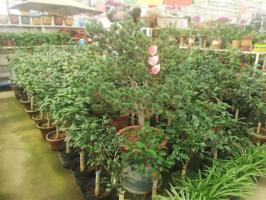Is 50 Degrees Too Cold for Potted Celosia Plants?
Celosia plants, also known as cock's comb, are a popular addition to any garden or indoor space. These vibrant and colorful plants are known for their fluffy, vibrant blooms that add a pop of color wherever they are placed. While celosia plants are relatively easy to care for, they are sensitive to temperature changes and extreme weather conditions. Many gardeners hesitate to grow celosia plants in colder climates, wondering if 50 degrees Fahrenheit is too cold for potted celosia plants.
The Ideal Temperature Range for Celosia Plants
The ideal temperature range for celosia plants is between 68-77 degrees Fahrenheit. However, celosia plants can tolerate temperatures as low as 50 degrees Fahrenheit for short periods of time. When temperatures drop below 50 degrees Fahrenheit, celosia plants become vulnerable to damage and can experience stunted growth, wilting, and even death.
Tips for Protecting Celosia Plants from Cold Temperatures
If you live in an area with cold temperatures, don't let that stop you from growing celosia plants. Here are some tips for protecting your celosia plants from cold temperatures:
Move your potted celosia plants indoors when temperatures drop below 50 degrees Fahrenheit.
If you can't move your plants indoors, cover them with a frost cloth or blanket to protect them from cold temperatures.
Place your celosia plants in a sheltered area to protect them from cold winds and extreme weather conditions.
Take care not to overwater your celosia plants during cold weather as this can lead to root rot.
Common Celosia Plant Problems During Cold Temperatures
During cold temperatures, celosia plants are vulnerable to a range of problems. Here are some common celosia plant problems to look out for during cold temperatures:
Wilting: Celosia plants may wilt or droop during colder temperatures.
Yellowing: The leaves of celosia plants may turn yellow or brown in colder temperatures.
Lack of Growth: Celosia plants may experience stunted growth during cold temperatures.
Disease: Cold and damp weather conditions can lead to fungal diseases such as powdery mildew.
If you notice any of these symptoms in your celosia plants during cold weather, take immediate action to protect them. Bring them indoors, cover them with a frost cloth, and ensure that they are not overwatered.
Conclusion
In conclusion, 50 degrees Fahrenheit is too cold for celosia plants to thrive in. While they can tolerate cold temperatures for short periods of time, prolonged exposure to cold temperatures can lead to damaged and stunted growth. To protect your celosia plants from cold temperatures, move them indoors, cover them with a frost cloth, and ensure that they are not overwatered. With proper care, you can enjoy your celosia plants year-round, no matter what the weather is like outside.

 how many times do yo...
how many times do yo... how many planted tre...
how many planted tre... how many pine trees ...
how many pine trees ... how many pecan trees...
how many pecan trees... how many plants comp...
how many plants comp... how many plants can ...
how many plants can ... how many plants and ...
how many plants and ... how many pepper plan...
how many pepper plan...
































